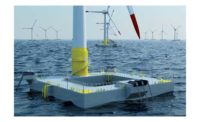Electric Utilities Recover from Record-Breaking Outages

Florida Power and Light prepared for Hurricane Irma with military precision. It deployed 17,000 workers, heavy equipment, poles and wires to 30 sites in the field ahead of the storm. In the end, it took 60,000 workers from 250 utilities in 30 states and Canada to restore power to Florida and other Southeastern states in the storm’s wake.
About 7.8 million utility customer accounts in the Southeast lost power. Of FPL’s 4.9 million customers, 4.4 million of them lost power—the largest outage in the company’s history. More than 1 million accounts lost power in Georgia.
The storm hit the Florida Keys on Sept. 9 as a Category 4 before winds slowed to 130 mph and Florida’s west coast. By Sept. 19, power had been restored to about 98% of those who could take power. Only the hardest hit areas or those with standing water were left without power,
FPL initially deployed forces to the east coast where the storm was expected to hit. Crews were repositioned to the west coast when Irma’s path changed.
The recovery phase included linemen, contractors, management teams, logistic teams, engineers and more, says Mike Vaughn, Entergy’s vice president of assets who helped lead the recovery after Harvey and sent crews to Florida. “It is a huge logistical challenge and takes a huge coordinated and team effort,” he says.
Entergy, which has won repeated awards for its storm preparedness, should know.
Since Katrina in 2005, Entergy has more than doubled its annual transmission budget to about $1 billion a year to harden its system. “Everything since then and in the future is designed with hardened standards but from a reliability perspective,” Vaughn says, meaning hardening upgrades will also improve day-to-day reliability. The work includes adding multiple source pathways, upgrading lines to 230-kV, raising substations and control houses, building levees, adding equipment to identify and isolate fault locations and more. The challenge is deciding how to protect assets for the future. The utilities then learn from each new storm, he says.
In one example, the company designed its system to National Safety Electric Code extreme wind criteria before Katrina, but the storm proved that standard was no longer good enough.
FPL also started a $3 billion effort to strengthen its power grid in 2006 after Hurricane Wilma, the sixth costliest storm in U.S. history, hit the state in 2005.
“Our structural damage will be limited,” says Eric Silagy, FPL president and CEO, of the impact of the storm hardening.
The ongoing upgrades made the power grid stronger, smarter and more storm resistant, says Bill Orlove, an FPL spokesman. The project should be completed by the end of the year when all main lines and community feeder lines will be upgraded.
The company has not completed its assessment of all damage, but the hardened feeder lines, those from the substations to the distribution transformers, performed 30% better than those that weren’t upgraded, FPL says.
Utility poles for the distribution system were also strengthened based on the wind load in each of the utility’s service areas, Orlove says. Palm Beach County poles are able to withstand winds of 145 mph, for example. Those that have been upgraded did not fail due to Irma’s winds, but were damaged by fallen trees. Some have been replaced with concrete structures, others with wood. Spans of overhead conductor have been shortened.
FPL’s transmission poles and towers, 90% of which are concrete or steel, did not fail due to wind during Irma, Orlove says.
Smart devices have been added to power lines to isolate issues and determine where a problem is, says Orlove. “They can communicate and reroute power,” he says. The technology was able to prevent 150,000 outages during the two 2016 hurricanes, Hermine and Matthew. The utility is also able to restore power more quickly during typical thunderstorms and after non-storm related problems.
FPL also has installed smart meters at 4.9 million homes and businesses and inspects its 1.2 million utility poles for strength in eight-year intervals, Orlove added.
Before the storm, FPL shut down two substations forecast to have extensive flooding and relied on real-time flood monitors at 223 substations.
FPL added the substation precautions as a lesson learned for Superstorm Sandy, which hit the northeast in 2012.
A storm surge of up to eight feet caused the Hudson, Hackensack and Passaic rivers to overflow causing damage to switching stations, substations and generating infrastructure. Following the storm, Public Service Electric & Gas, New Jersey’s largest utility, raised or eliminated 12 substations that flooded as part of a $1.2 billion system hardening program.
The utility had proposed $3.9 billion in resiliency investments, leaving two-thirds of its plan on the drawing board when regulators approved only a part of its plan, the company says.
Duke Energy has a $25 billion plan to modernize its energy grid in Florida, the Carolinas and the mid-west over 10 years. More than half will be spent in North Carolina, $4.9 billion to bury power lines, $2.2 billion upgrading the transmission system and $3.5 billion on the distribution system and $1 billion on advanced metering and system communications. In Florida, the utility will invest $3.4 billion, including $600 million to underground lines and $780 million on distribution hardening and resiliency.
The utility industry is focused on the resiliency of individual systems, says Entergy’s Vaughn. “And after a storm we’re all on the same team to share people and equipment to restore power quickly and safely to customers.”




